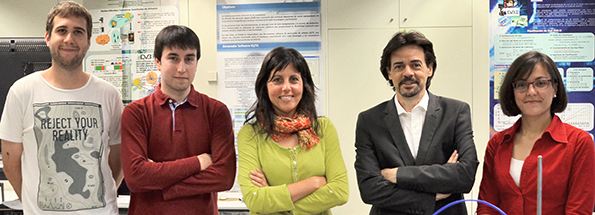Phantoms
The UPV develops new synthetic models for creating technology medical examination and testing of devices 5G
[ 13/07/2016 ]
Researchers at the Universitat Politècnica de València (UPV) have developed new synthetic models (phantoms) that simulate the electromagnetic properties of several human tissues and organs, such as complex relative permittivity, dielectric constant, loss factor and conductivity. These models may be of interest for developing new technologies for medical screening, and in general, for testing 5G mobile communication devices. The researchers also devised the methodology to create the phantoms.
Recently, there has been a growing interest in the use of new telecommunication devices that facilitate clinical diagnosis when implanted in the organism. These units can be integrated inside capsules and taken orally. This is the case for sensors and medical monitoring systems that register biological information inside the body and later transmit it outside.
Electromagnetic waves through the body
According to UPV researchers, these devices wirelessly communicate sending electromagnetic waves through the body, which acts as a transmission medium. In order to develop and test them before they are marketed, it is necessary to perform tests on animals and humans.
In fact, the models and methodology developed by the researchers and patented by the Universitat Politècnica de València will reduce testing on animals and humans. They will help to assess the transmission of electromagnetic waves in UWB (ultra-wide band) frequency, which is between 3.1 and 10.6 GHz; and will take part on future personal area networks, as well as other networks of narrower bands, such as ISM networks.
The phantom is a liquid mixture or a crosslinked polymer (hydrogel) that can be formed according to the shape and size of interest, in order to simulate a specific organ at an electromagnetic level that is able to hold those liquids or mixtures.
Simulating "on demand"
With the new methodology developed by the researchers, organs such as the liver, heart, pancreas, colon and cartilage can be simulated “on demand” from an electromagnetic point of view. For some of them, there are no phantoms on the market today, nor proposals for any in the future, not even for a specific frequency.
Noticias destacadas
 Hasta 900€ por estudiante
Hasta 900€ por estudiante
La UPV pone en marcha su convocatoria de ayudas de acción social para el presente curso académico
 Lucha contra el ciberacoso sexual a menores
Lucha contra el ciberacoso sexual a menores
La UPV ha organizado el congreso internacional Enfoques Interdisciplinares para la Protección de la Infancia en Internet, del proyecto de investigación Stoponsexgroom
 Edicions Maior: 25 años
Edicions Maior: 25 años
La UPV exhibe una selección excepcional de la histórica galería balear, referencia internacional de la gráfica contemporánea
 QS rankings por materias
QS rankings por materias
La UPV, reconocida como mejor universidad de España para estudiar tanto Ingeniería Agroalimentaria y Forestal como Arte y Diseño
 Activa tu futuro
Activa tu futuro
El CFP organiza talleres, ponencias y actividades para dar a conocer los títulos propios de la UPV
 Éxito de la nueva edición del Foro de empleo del campus de Gandia
Éxito de la nueva edición del Foro de empleo del campus de Gandia
Más de 300 jóvenes han asistido a la feria del empleo, que ha reunido a 44 entidades con un centenar de ofertas







